
Mammillaria karwinskiana (syn. subsp. nejapensis) (Silver Arrows) after I brought it home on 9-21-18, #510-7.
Silver Arrows, Royal Cross
Mammillaria karwinskiana
mam-mil-AR-ee-uh kar-winz-kee-AH-na
Syn.
Mammillaria karwinskiana subsp. najapensis
Synonyms of Mammillaria karwinskiana (2) (Updated on 12-8-23 from Plants of the World Online): Cactus karwinskianus (Mart.) Kuntze (1891), Neomammillaria karwinskiana (Mart.) Britton & Rose (1923)
Synonyms of Mammillaria karwinskiana subsp. karwinskiana (64) (Updated on 12-8-23 from POWO): Cactus bergii Miq. (1840), Cactus fischeri (Pfeiff.) Kuntze (1891), Cactus geminatus (Scheidw.) Kuntze (1891), Cactus pyrrhocephalus (Scheidw.) Kuntze (1891), Cactus subpolyedrus Kuntze (1891), Cactus virens (Scheidw.) Kuntze (1891), Mammillaria beiselii Diers (1979), Mammillaria bergii (Miq.) Walp. (1843), Mammillaria closiana Roum. (1855), Mammillaria confusa (Britton & Rose) Orcutt (1926), Mammillaria confusa var. centrispina R.T.Craig (1945), Mammillaria confusa var. conzattii (Britton & Rose) R.T.Craig (1945). Mammillaria confusa var. robustispina R.T.Craig (1945), Mammillaria conzattii (Britton & Rose) Orcutt (1926), Mammillaria ebenacantha Shurly (1961)(no Latin descr.), Mammillaria fischeri Pfeiff. (1836), Mammillaria flavescens Zucc. ex C.F.Först. & Rümpler (1885)(not validly publ.), Mammillaria flavescens Pfeiff. (1837)(nom. illeg.), Mammillaria geminata Scheidw. (1841), Mammillaria geminata subsp. beiselii (Diers) Rebmann (2020), Mammillaria geminata subsp. nejapensis (R.T.Craig & E.Y.Dawson) Rebmann (2020), Mammillaria jalappensis Pfeiff. (1837), Mammillaria jozef-bergeri Wojn. & Prajer (1969), Mammillaria karwinskiana subsp. beiselii (Diers) D.R.Hunt (1997), Mammillaria karwinskiana var. flavescens Zucc. ex Pfeiff. (1837), Mammillaria karwinskiana subsp. nejapensis (R.T.Craig & E.Y.Dawson) D.R.Hunt (1997), Mammillaria karwinskiana var. virens (Scheidw.) Salm-Dyck (1845), Mammillaria karwinskii Zucc. ex J.Forbes (1837), Mammillaria malletiana Cels (1848), Mammillaria malletiana f. fulvolanata (Hildm.) Schelle (1926), Mammillaria malletiana var. pyrrhocephala (Scheidw.) Schelle (1926), Mammillaria multiseta C.Ehrenb. (1849), Mammillaria nagliana Repp. (1987), Mammillaria nejapensis R.T.Craig & E.Y.Dawson (1948), Mammillaria nejapensis var. brevispina R.T.Craig & E.Y.Dawson (1948), Mammillaria nejapensis f. brevispina (R.T.Craig & E.Y.Dawson) Krainz (1961), Mammillaria nejapensis f. longispina (R.T.Craig & E.Y.Dawson) Krainz (1961), Mammillaria nejapensis var. longispina R.T.Craig & E.Y.Dawson (1948), Mammillaria nejapensis var. typica R.T.Craig & E.Y.Dawson (1948)(not validly publ.), Mammillaria neomystax Backeb. (1952), Mammillaria parmentieri Link & Otto (1830),Mammillaria polygona Zucc. ex Pfeiff. (1837), Mammillaria pyrrhocephala Scheidw. (1841), Mammillaria pyrrhocephala var. confusa (Britton & Rose) Borg (1937), Mammillaria pyrrhocephala var. donkelaerii Salm-Dyck (1850), Mammillaria pyrrhocephala var. malletiana (Cels) Borg (1937), Mammillaria seitziana Miq. (1838)(nom. illeg.), Mammillaria strobilina Tiegel (1933), Mammillaria subpolyedra Salm-Dyck (1850), Mammillaria tropica Repp. (1987), Mammillaria virens Scheidw. (1841), Neomammillaria confusa Britton & Rose (1923), Neomammillaria confusa var. centrispina (R.T.Craig) Y.Itô (1981)(without basionym ref.), Neomammillaria confusa var. robustispina (R.T.Craig) Y.Itô (1981)(without basionym ref.), Neomammillaria conzattii Britton & Rose (1923), Neomammillaria nejapensis (R.T.Craig & E.Y.Dawson) Y.Itô (1981)(without basionym ref.), Neomammillaria nejapensis var. aureispina Y.Itô (1981)(not validly publ.), Neomammillaria nejapensis var. brevispina (R.T.Craig & E.Y.Dawson) Y.Itô (1981)(not validly publ.), Neomammillaria nejapensis var. elegans Y.Itô (1981)(not validly publ.), Neomammillaria nejapensis var. longispina (R.T.Craig & E.Y.Dawson) Y.Itô (1981)(not validly publ.), Neomammillaria neomystax (Backeb.) Y.Itô (1981)(without basionym ref.), Neomammillaria neomystax var. rhodacantha (Y.Itô) Y.Itô (1981)(not validly publ.), Neomammillaria pyrrhocephala (Scheidw.) Britton & Rose (1923), Neomammillaria subpolyedra (Salm-Dyck) Britton & Rose (1923)
The label said this plant is a Mammillaria nejapensis but, according to Plants of the World Online by Kew, Mammillaria nejapensis is a synonym of Mammillaria karwinskiana subsp. karwinskiana. Ummm… Along with 64 other previous scientific names…
Mammillaria karwinskiana Mart. is the accepted name for this species. It was named and described by Carl (Karl) Friedrich Philipp von Martius in Nova Acta Physico-Medica… in 1832.
The synonym, Mammillaria nejapensis R.T.Craig & E.Y.Dawson, was named and described by Robert T. Craig and Elmer Yale Dawson in Allan Hancock Foundation: Occasional Papers in 1848.
As of 12-9-23 when this page was last updated, Plants of the World Online by Kew lists 138 species in the Mammillaria genus. It is a member of the plant family Cactaceae with 150 genera. Those numbers could change as updates are made on POWO. The number of species in the genus and genera in the family fluctuates on occasion.
Mammillaria karwinskiana is a “variable’ species and there were several recognized varieties. Even though they are not currently recognized, the variations still exist in this species so that needs to be considered when trying to identify unlabeled plants. This particular plant in my collection was likely Mammillaria nejapensis var. longispina (1948) which was also a synonym of Mammillaria karwinskiana subsp. nejapensis (1997). Well, heck, there are 45 synonyms so it was given a multitude of names. It would be hard to tell at this point which ones were for this plant or the other variations. Personally, I think the variations should still be accepted names instead of them being considered just synonyms of the species. The variations exist and should be recognized.
THERE ARE SEVERAL LINKS AT THE BOTTOM OF THE PAGE FOR FURTHER READING.

Mammillaria karwinskiana (syn. subsp. nejapensis) (Silver Arrows) on 9-21-18, #510-8.
I brought this plant home from Lowe’s on September 21, 2018. The label said it was a Mammillaria nejapensis but upon research, I found that name is a synonym of Mammillaria karwinskiana. The label further says:
“Native to Oaxaca, Mexico, forms globular stems with silvery white spines, dense wool at the areoles. Becomes slightly columnar, branching to form large clusters. Flowers are pale yellow with reddish midstripe. Water thoroughly when soil is dry.”
The plant measured approximately 1 7/8” tall x 2 3/16” wide without the spines and was growing in a 4 oz. (2 1/2″ diameter pot.
Mammillaria karwinskiana (subsp. nejapensis) is native to a wide area around Oaxaca City in Mexico where it is found in tropical deciduous forests and shrubby dry areas. It initially grows as a solitary specimen and slowly divides dichotomously or branches out basally. I believe the species or some of the subspecies (GEEZ!) is found as far down as Guatemala.

Mammillaria karwinskiana (syn. subsp. nejapensis) (Silver Arrows) from the top on 9-21-18, #510-9.
Mammillaria karwinskiana is one of only a few Mammillaria species commonly referred to as “Owl Eye Cactus” known for their dichotomous branching. This means the plant (stem) divides into two parts. Then the two become 4 and so on… I haven’t experienced this yet, but it could get interesting.
It is a globular-shaped or cylindrical cactus that can be from blue-green to dark green in color and can grow to around 8” tall. One feature is all the long wool… My plant only had small threads when I first brought it home in 2018, but within a year it wasn’t recognizable as the same plant…
Mammillaria karwinskiana is a very variable species, especially for the length of the spines. My particular plant, as I mentioned, is likely Mammillaria karwinskiana subsp. nejapensis, so this description is for that subspecies, even though it is currently listed as a synonym of the species.
As with basically all Mammillaria, its prominent tubercles are arranged in a spiral pattern. This (sub) species has 3-5 straight to slightly curved radial spines, kind of off-white color, some with brown tips. The upper spines on the areoles are shorter, the two on the sides are somewhat longer, and the lower one is much longer. As the plant has grown, the spines growing from the apex (top) of the plant are much longer, almost 1”. As the plant grows, those longer lower spines point downward. They are very thin and sharp! OH, when the plant was smaller, the areoles had small tufts of wool. As the plant grew larger and woolier, only the upper areoles have wool.
The axils between the tubercles had small amounts of threads when the plant was smaller, but now it is downright wooly around the top of the plant. The wool looks like it spirals down the axils on the side of the plant about halfway down. The lower 1/3 appears to have none.

Mammillaria karwinskiana (syn. subsp. nejapensis) (Silver Arrows) on 10-10-18, #519-47.
I moved the potted plants inside for the winter on October 10 because the weather forecast said we would be having an “F” in a few days and the evening temperatures were going to be dropping. I always measure the cactus and some of the succulents when I move them inside to see how much they have grown in the past year. I didn’t measure this plant then because I only had it for a short time and it hadn’t grown.
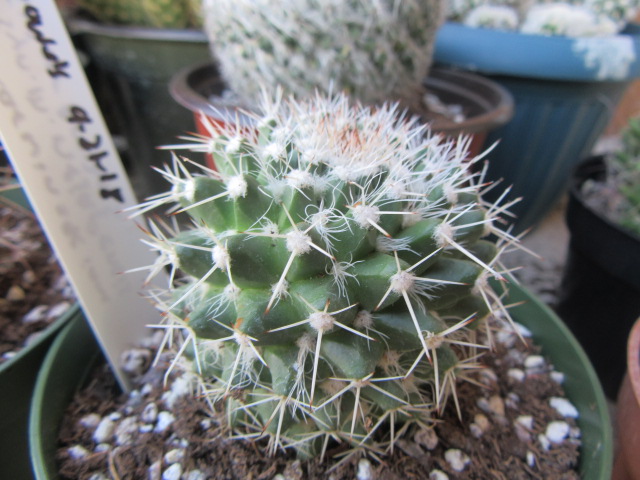
Mammillaria karwinskiana (syn. subsp. nejapensis) (Silver Arrows)on 11-29-18, #534-19.
November 29 was a nice spring-like day, so I took the cactus to the back porch for a photoshoot. I was working on a post to show the difference between the cactus in my collection.
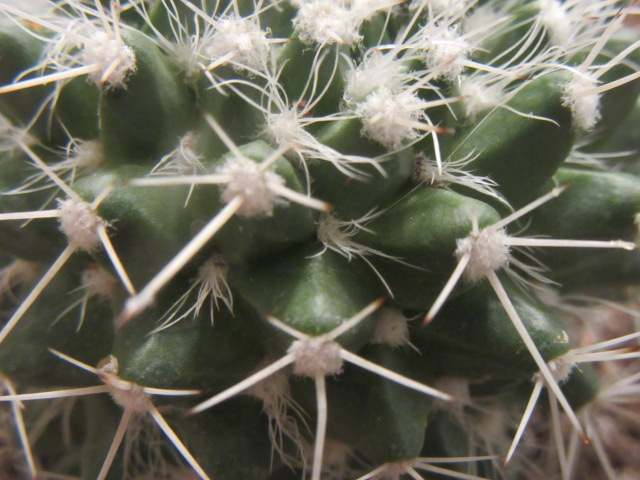
Mammillaria karwinskiana (syn. subsp. nejapensis) (Silver Arrows) close-up on 12-1-18, #535-15.
In the above photo, you can see the areoles have small tufts of wool, five radial spines, and no central spines. The axils (the area between the tubercles) look like they are growing hair… In time, this hair gets longer and thicker making the plant look very wooly.
<<<<2019>>>>

Mammillaria karwinskiana (syn. subsp. nejapensis) (Silver Arrows) on 6-22-19, #593-29.
The potted plants are enjoying being outside for the summer. Most of the cacti are on the back deck in full sun.
I was fairly busy during the summer so I wasn’t able to take a lot of photos. The cactus all did very well despite a little neglect.

Mammillaria karwinskiana (syn. subsp. nejapensis) (Silver Arrows) at 3 1/4″ tall x 2 3/4″ wide on 10-11-19, #639-61.
I had to move the potted plants inside for the winter on October 11 because an “F” was in the forecast. I always take photos of the plants when I bring them inside and measure the cactus and some of the succulents. The Mammillaria karwinskiana measured 3 1/4″ tall x 2 3/4″ wide. It was only 1 7/8″ tall when brought it home on 9-21-18 so it has grown a lot. The hair on this plant has become wool!

Mammillaria karwinskiana (syn. subsp. nejapensis) (Silver Arrows) from the top on 10-11-19, #639-63.
The Mammillaria karwinskiana is fairly wooly, but not as much as the Mammillaria hahniana. I could not remember if there were buds when I brought the cactus inside or not. Kind of hard to tell what is under the wool. The top of cactui always looks neat. For sure, the wool on this cactus has gotten A LOT thicker. Maybe it is growing more for the winter. 🙂

Mammillaria karwinskiana (syn. subsp. nejapensis) (Silver Arrows) on 11-11-19, #648-4.
The flowers were beginning to open when I took this photo on November 11. It is always interesting how the buds form and open facing the inside of the house first instead of the sunny side.

Mammillaria karwinskiana (syn. subsp. nejapensis) (Silver Arrows) on 11-11-19, #648-5.
I am really glad the flowers aren’t pink like several other Mammillaria in my collection. Information on Llifle says the flowers of this species are creamy-white to yellow with maroon midveins.

Mammillaria karwinskiana (syn. subsp. nejapensis) (Silver Arrows) flowers on 11-18-19, #653-1.
NICE!

Mammillaria karwinskiana (syn. subsp. nejapensis) (Silver Arrows) flowers on 11-18-19, #653-2.
Well, that is just darn AWESOME!!!

Mammillaria karwinskiana (syn. subsp. nejapensis) (Silver Arrows) on 11-18-19, #653-3.
There are more buds almost all the way around the plant.

Mammillaria karwinskiana (syn. subsp. nejapensis) (Silver Arrows) on 11-23-19, #655-4.
I took this photo when the flowers were fully open and some of the earlier ones are beginning to get a little droopy.

Mammillaria karwinskiana (syn. subsp. nejapensis) (Silver Arrows) on 11-14-19, #660-1.
There were eleven buds and flowers when I took the above photo on November 14. These buds are on the backside of the plant.
<<<<2020>>>>

Mammillaria karwinskiana (syn. subsp. nejapensis) (Silver Arrows) at 3 5/8 tall x 3″ wide on 10-15-20, #747-69.
I had to move the plants inside for the winter on October 15 because an “F” was in the forecast. As always, I took photographs and measurements as I brought the cactus inside. The Mammillaria karwinskiana measured 3 5/8″ tall x 3″ wide.

Mammillaria karwinskiana (syn. subsp. nejapensis) (Silver Arrows) with lots of wool for the winter on 7-15-20, #747-70.
The wool on the Mammillaria karwinskiana (subsp. nejapensis) looks like little tufts. Pretty neat, huh?

Mammillaria karwinskiana (syn. subsp. nejapensis) (Silver Arrows) with flowers on 11-1-20, #754-2.
The Mammillaria karwinskiana started flowering shortly after I brought it inside.
<<<<2021>>>>
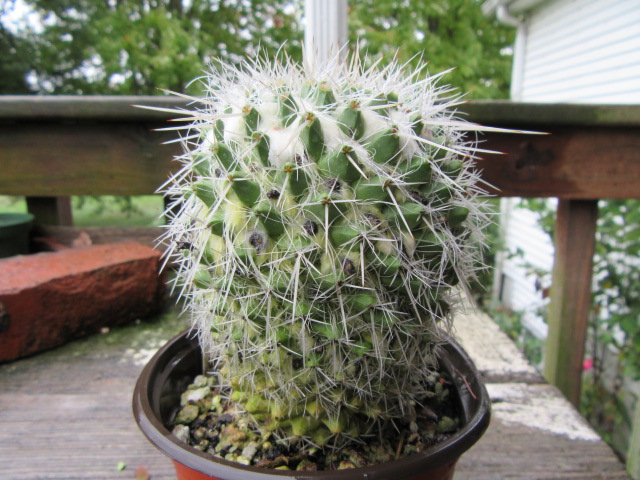
Mammillaria karwinskiana (syn. subsp. nejapensis) (Silver Arrows) at 4″ tall x 35/8″ wide on 10-28-21, #853-15.
I didn’t have to move the potted plants inside for the winter until October 28 in 2021. There wasn’t a chance of “F” in the forecast until then which was quite unusual. It had been raining so the wool on the Mammillaria karwinskiana was wet when I took the photo. It did very well over the summer and grew to 4″ tall x 3 5/8″ wide.
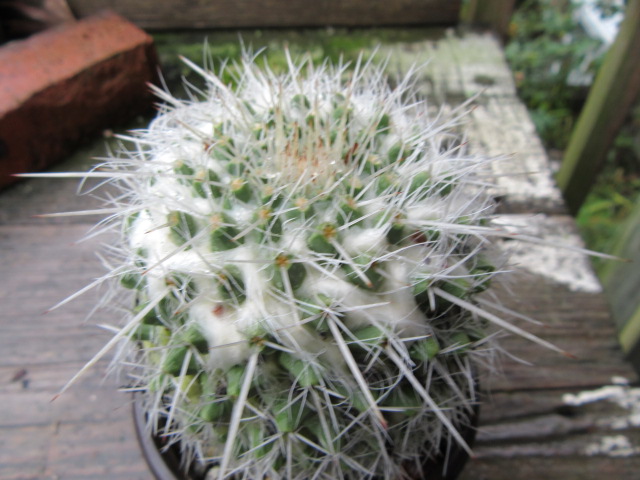
Mammillaria karwinskiana (syn. subsp. nejapensis) (Silver Arrows) from the top on 10-28-21, #853-16.
I really like this plant and the way its wool weaves through its tubercles.
USEFUL INFORMATION:
Family: Cactaceae
Origin: Central and Southwest Mexico and Guatemala
Zones: USDA Zones 9b-11 (25-40° F)
Size: Hmmm… Maybe up to 8” or so tall.
Light: Sun to light shade. If grown inside over the winter, you should gradually increase the amount of light gradually when you put them outside.
Soil: Very well-draining soil. Potting soil amended with perlite and grit or pumice.
Water: Average during the summer and very seldom during the winter. Allow to dry out between watering
You can read my Cactus Talk & Update and Cactus & Succulent Tips to get my opinion about growing cacti and succulents.
When you bring your new plants home from the store, you need to check their roots and the soil to see if they are wet. If so, you may want to repot it right away. It is advisable to re-pot them in a better potting soil more suitable for cacti and succulents.
<<<<2022>>>>

Mammillaria karwinskiana (Silver Arrows) at 4 1/2″ tall x 3 1/2″ wide on 10-16-22, #919-25.
It was that time of year again to bring the potted plants inside for the winter because an “F” was in the forecast. The Mammillaria karwinskiana did very well and grew another 1/2″ to 4 1/2″ tall x 3 1/2″ wide. I kept the cactus on the front porch with the succulents in 2022 so they could have a little more shade. They all did quite well even with a little neglect…
<<<<2023>>>>
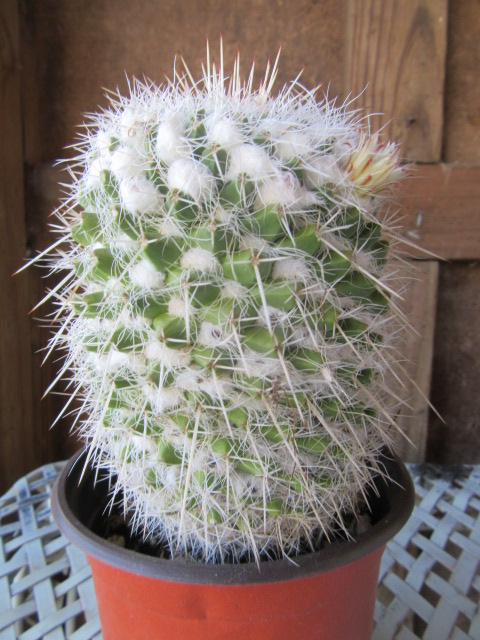
Mammillaria karwinskiana (Silver Arrows) at 5″ tall x 3 1/2″ wide on 10-23-23, #967-24.
Even though there was no “F” in the forecast until October 30, it was going to be a rainy week so I moved the potted plants inside on the 23rd and 24th. Time for photos and measurements…
The Mammillaria karwinskiana did very well during the summer on the back porch in full sun despite the heat and drought. It measured 5” tall x 3 1/2” wide when I moved it inside for the winter.

Mammillaria karwinskiana (Silver Arrows) on 10-23-23, #967-25.
I will continue adding more photos and information as time goes by. This one will be interesting to watch and see how long it takes the stem to split. 🙂
I hope you enjoyed this page and maybe found it useful. I would like to hear from you if you have any comments, questions, or suggestions. Please click on “like” if you visited this page. It helps us bloggers stay motivated. 🙂 You can check out the links below for further reading. The links take you directly to the genus and species of this plant.
So happy I was finally able find out what type of cactus I had, and that it was normal for it to “split” into 2! Mine is five years old and has two heads, it almost looks like a heart.
LikeLiked by 1 person
Hello Hannah! That sounds great! I have several that are supposed to do that. It will be interesting. Take care and thanks for the comment!
LikeLike
Did you get any seed pods on yours? I purchased mine in the spring from Lowes, didn’t see it flower at all, and over this past month it’s starting to produce magenta seed pods. Could there really be that much of a delay?
LikeLike
Hello Laura! The same thing happened with me several years ago. I had bought a Mammillaria elongata on 3-19-18 and I noticed a fruit on 6-28-19. I never saw a flower so likely it bloomed before I brought it home. It produced A LOT of flowers in 10-19 but has not flowered since and hasn’t had fruit because the flowers didn’t get pollinated. With as many cactus as I have that flower quite often, some with a lot of flowers, they don’t produce fruit. The flowers have to be pollinated to produce fruit. Most cactus are not self-fertile, meaning the female flowers need to be pollinated with the pollen from a male flower of a different plant of the same species. I hope this answers your question. Take care and thanks for the comment.
LikeLike